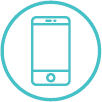YES! Visit our remote lice treatment page for more details.
Many symptoms are mistakenly diagnosed as head lice. Dandruff, gobs of hairspray and even small insects like aphids that have been blown into the hair on a windy day have all sent panicky parents to the pediatrician for treatment. The only foolproof diagnosis for pediculosis (a head lice infestation) is to
catch sight of the elusive bugs, but look for these signs as well:
- Persistent scratching of the scalp
- Pink rash behind the ears and at the nape of the neck, resembling an allergic reaction
- Tiny lice eggs (called “nits”) on the hair shafts, close to the scalp, that cannot be brushed off
- The presence of tiny light brown bugs (the size of a sesame seed)
Children get head lice most often from direct head-to-head contact with an infested individual, but it is possible (although more unlikely than you think) to pick them up from sharing hats, pillows, hairbrushes, helmets, towels, etc. The good folks at the Harvard University School of Public Health entomology lab were unable to get them to spread via hats and scarves, but not for lack of trying. According to the American Academy of Pediatrics, a healthy louse rarely leaves a healthy head because lice can’t survive or breed without a human scalp to supply their meals and keep their babies warm. So unless they’re injured or dying, they’ll be hanging on tight. Their survival depends on it.
Lice do NOT jump or fly, but they do crawl rapidly through the hair. Simply treating a child for head lice does not put you in danger of contracting them, unless you have direct head-to-head contact. It’s a good idea to get yourself screened, however because it’s a good bet that you’ve recently had that kind of affectionate contact with your kids.
Follow-up combing should be performed for a full two weeks. If this seems like overkill, well, you could argue that it is, but what better time for overkill than when head lice invade? Consider it quality time spent with your children.
To prevent re-infestation, do weekly screenings using a metal nit comb, pull back long hair into a ponytail or braid, and teach your children to avoid head-to-head contact, use common sense, and stay away from sharing personal items. Do not instruct children to avoid appropriate contact with an infested child, as this will spread stigma and cause unnecessary stress. Remember, children will follow your lead, so a cool head and an informed mind should prevail!
According to the Harvard School of Public Health, the greatest harm to children or adults associated with head lice “results from the well-intentioned but misguided use of caustic or toxic substances to eliminate the lice.”
They have not been shown to carry disease, but secondary infection is certainly possible if the itching causes the scalp to be scratched to the point where bacteria can be introduced to damaged skin.
It is not currently possible to determine the identity of the donor. Parents should resist the urge to assign blame, as it is unproductive, and spreads stigma rather than knowledge. Instead of accusing other parents or school administrators of not doing enough to stop the spread of head lice, parents are better served by screening and treating their families, and informing other parents and school administrators that a problem exists.
Dogs do not, we repeat, do NOT harbor or spread human head lice. Same goes for cats. Ticks, perhaps; fleas, maybe. Don’t torture Fido or Fluffy with unnecessary and potentially harmful treatments developed for humans.
Just as you’d want to know, the parents of your child’s friends will appreciate the information so that they can screen their children. The school nurse will also appreciate knowing about it, so she can screen the rest of the class and get the word to other parents discreetly and compassionately. Remember our motto: No Shame, No Blame!
In our experience, the most effective head lice treatment involves a thorough, meticulous combing, using a metal nit comb and a non-toxic, pesticide-free enzyme product that eases the combing process without making the lice, nymphs or nits impossible to see. Follow up combing every day for two weeks is the best insurance against re-infestation, as it will remove any hatched nymphs or nits that are missed during the initial combing.
There are no shortcuts here, and conscientious follow-up combings are necessary to make it an effective head lice treatment.
Check with your pediatrician for recommendations that take into consideration the age and health of your child,and any allergies or other conditions such as asthma that may render treatment using chemical or pesticidal compounds risky or unsafe. The most effective head lice treatment method is manual removal with a professional nit comb, as risk to your child is minimal and nits can be removed, breaking the bugs’ life cycle.
Most re-infestations are really continuations of the original one. If hair is not meticulously combed with a high-quality nit comb every day for two weeks to remove nits or hatched nymphs, head lice will mature and mate, causing the cycle to repeat. There have been reports of head lice becoming resistant to some of the chemicals used in these products, which could also be a factor, but the most likely scenario is incomplete removal or re-exposure to an infested person.
Human head lice cannot survive more than a day or so when removed from a host. Lice found off a human head are likely to die within 6-24 hours; according to the American Academy of Pediatrics, “Lice found on combs are likely to be injured or dead, and a healthy louse is not likely to leave a healthy head.” This is important to remember, and is the key to easing anxiety about head lice living or breeding in your home. Simply put, any louse found off a head is in the process of dying.
It might be a little hard to believe when you’re in the midst of an infestation, but it is not possible for your house to be infested with head lice. That’s the good news.
Head lice cannot survive for very long away from a human host, so they will not successfully breed in your home, lying in wait for their next victim. One or two head lice may have made the mistake of leaving an infected person’s head; those unlucky critters will live for only a few hours to a day or so at most (scientific journals say between 6 and 24 hours), then perish.
Nits attached to hairs that fall out are unlikely to hatch off the head. They need the heat and humidity of the scalp to incubate them. It’s like taking a chicken egg out from under a hen, the egg will never hatch!
The bad news is that most people tend to overreact, thinking that they need to sterilize everything in the house, or that they need to bomb the house with pesticides (expensive, unhealthy, and unnecessary!). If you want peace of mind, here’s what you should do:
- For washable items like sheets, pillowcases and recently worn clothing, use water at the appropriate temperature for the fabric and your regular detergent.
- For hair items (combs, brushes, hair ties etc.) put in a ziplock bag and put in freezer for 24 hours. Extremes in temperature (hot or cold) will kill any lice or nits.
There is no need to bag household items for several weeks. There is no need to sprinkle baking soda on
everything you own, and there’s no substance on earth that can “activate” baking soda and transform it into a head lice killer. Head lice cannot cling to plastic or glass, and their specialized claws make it difficult for them to maneuver in any fibers other than human hair. The biology of Pediculus capitis will doom any louse that goes rogue, within hours of its escape.
If you’ve got the patience and the tools, by all means, get a professional-grade nit comb and try it yourself. Remember, meticulous combing is the key to effective head lice removal, and conscientious follow-up is a must. If you choose to go the chemical route, read the instructions carefully, as they may pose a health risk in some individuals, especially children with asthma. Many of these products involve multiple treatments, yet still require thorough combings, and they tend to include cheap plastic combs, which researchers have found to be ineffective.
If the ICK! factor is too great, or you’ve tried unsuccessfully to treat your family with over-the-counter or prescription medications, it’s probably time to call in the pros to help you break the cycle safely and with minimal disruption to your family and your schedule.
There are tons of websites on the Internet, and we know that it’s difficult to separate the ones with real information from the ones that spread misinformation and fear. We think that the scientists at the Laboratory
of Public Health Entomology at the Harvard School of Public Health have written up some of the most practical advice you can get, and we’ve trusted them for a lot of the scientific background for our site. We’ve also used clinical reports from the American Academy of Pediatrics, information from the National Institutes of Health (NIH), the American Academy of Family Physicians, and the Centers for Disease Control. Each of these organizations has one or more websites you can visit for more detail than you can imagine.
Most plans provide reimbursement through health savings accounts (HSA) or flexible spending accounts (FSA). Check with your provider to determine whether head lice remediation products and services qualify as covered expenses.
Call the Lice Happens LiceLine at 443.510.4480, and one of our certified lice treatment specialists will be happy to give you the information or advice that you need.

ASK THE NURSE!
MJ ECKERT, RN
Co-Founder &
Lice Treatment Specialist
I’ve dealt with hundreds of families affected with head lice during my sixteen years as a nurse, especially during the last seven years as a school and camp nurse. I find it very rewarding to help families get their lives back to normal by providing hands-on treatment to eliminate the infestation, and straightforward, accurate information to help families avoid the cycle of re-infestation.
The feeling of satisfaction I have after helping a family through this experience, and giving them the tools and knowledge they need to tackle the problem, is what I love most about the work we do at Lice Happens.



